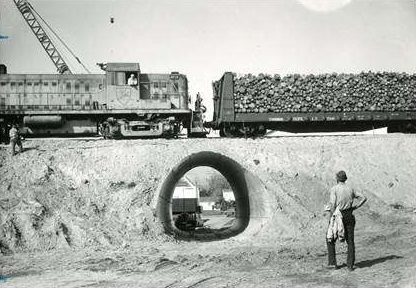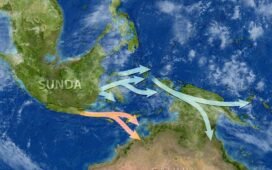
 Travel through the Saratoga County community of Corinth, NY, was difficult at best in the mid-nineteenth century. The Hudson River was navigable only a few months of the year. At a time when roads were rutted, muddy, or ice and snow covered the railroad offered the best form of reliable transportation for passengers and goods.
Travel through the Saratoga County community of Corinth, NY, was difficult at best in the mid-nineteenth century. The Hudson River was navigable only a few months of the year. At a time when roads were rutted, muddy, or ice and snow covered the railroad offered the best form of reliable transportation for passengers and goods.
The Adirondack Railroad from Saratoga Springs to Hadley was completed at the end of the Civil War in 1865. The rail system helped spur industrial development in the area with the advent of dependable transportation.
Trains transported heavy equipment of the newly established Hudson River Pulp and Paper Company to Corinth in 1869 and rolls of paper were sent to market. By 1874 over two tons of fine quality printing paper were produced annually.
Unfortunately, the railroad was located a few miles away and freight had to be hauled by horse drawn wagons to the Corinth station. By 1888, the company had constructed a branch line through the village to the upper part of the mill. This coincided with the expansion of the facility when five more paper machines were added. Pulpwood was also delivered by rail.
The railroad also offered an efficient method of delivering US Mail to the area. The post office had begun using the Adirondack rail system in 1869. Charles E. Cudney made the delivery to Corinth and Palmer Falls twice a day from the railroad station over 35 years by horse and later using his autobus which also transported passengers to and from the station.
A variety of people and animals were transported into town by the rail system. In July 1904, the Sig Sautelle Circus came to Corinth, bringing along over 200 men and women. (Sig Sautelle’s real name was George Satterly, the son of a shoemaker born in Luzerne, NY in 1848.)
The attractions included clowns, cowboys, cowgirls, Indians, golden chariots, wild beasts, hundreds of horses, camels, a steam calliope, and an assortment of elephants. Clarence Flora had 1,000 baby chicks delivered by parcel post from a hatchery in New Jersey in the spring of 1927.
Materials of all kinds arrived at the Corinth station. In 1930 an entire Aladdin House kit was delivered by rail into the village along Palmer Avenue. The partially prefabricated house was erected next to the Baptist Church to become the new parsonage. In 1905 a coal elevator was constructed near the International Paper spur line. Dennis O’Brien operated a coal business on Third Street and would have his coal deliveries come in by rail.

 Passengers of all kinds rode the rails over the years for both business and pleasure. In the early 1890s a group of Theosophists arrived in Corinth to build a retreat on a 165-acre farm. They presented lectures about Karma and reincarnation that drew hundreds by rail to witness the outdoor programs.
Passengers of all kinds rode the rails over the years for both business and pleasure. In the early 1890s a group of Theosophists arrived in Corinth to build a retreat on a 165-acre farm. They presented lectures about Karma and reincarnation that drew hundreds by rail to witness the outdoor programs.
Organized by Christoph Maschmedt, he also purchased a store stocked with imported items, traveling to New York City by rail to purchase his inventory. Maschmedt was eventually charged with fraud and made a final rail trip to New York City where he was arrested. All his property and stock were sold off to pay his creditors.
In September 1901 Vice President Theodore Roosevelt was enjoying hiking in the Adirondacks after taking the train up to North Creek. He knew that President William McKinley was recovering from an assassination attempt five days earlier.
An urgent message was telegraphed to North Creek telling Roosevelt to return to Washington, D.C, the president was dying. By the time Roosevelt reached the end station at the end of the line the president was dead. Each station master along the way was instructed to offer any assistance necessary.
Mike Burke was the station master at Corinth. When he heard the whistle from up the line he rushed to the platform, but the train passed the station and stopped about a mile down the line at Hadfield’s Switch to take on water for the steam engine.
Burke ran down the line and as he approached the final Pullman car he heard someone yell “Halt”. It was Roosevelt’s guards with guns in hand. Burke told the men he was the station master and had been instructed to help in any way necessary. The men replied, “We don’t need anything, just turn around and go back.” Mike Burke did as he was told.
In 1910 a strike occurred at the paper mill after an employee was fired without explanation. Tensions had been strained since the company did not recognize the union that had been formed by the workers and refused to negotiate in good faith.
Violence broke out and rail cars carrying strikebreakers were attacked and a trestle set fire. The New York State militia was sent in by rail to quell the uprising and escort the strikebreakers into the mill. After ten weeks the strikers agreed to return to work.
The trains also brought summer visitors. In July and August 1905 carloads of 145 Fresh Air Children from New York City arrived at Corinth. The children then spent two weeks in the area enjoying the outdoors and country life.
The train also brought problems to the area. The engines emitted embers that created a fire hazard along the tracks, especially in the dry spring months.
Ambrose C. Hickok, local fire warden, kept an account book. His entries of April 1905 show how frequently these fires occurred.: April 8 – five acres burned, April 14 – 11 total acres, April 17 – 8 acres, April 18 – 5 1/2/ acres, April 20 – 4 acres, and April 24 – 75 acres of pastures and meadows burned along the tracks.
Slowly the rail service in Corinth declined. A depot was built in South Corinth in 1880, but by the summer of 1924 the station agent position was eliminated and 1933 marked the last time the train stopped at that location.
The Corinth station located on upper Hamilton Avenue (originally called Railroad Avenue) was constructed in 1865. A new passenger station was built in 1911 after local officials complained about the dilapidated conditions of the old depot.
The station ceased operations in 1977. Passenger use on the railroad had diminished over the years. Competition from autobuses as well as individual automobiles dramatically cut into the number of passengers using the trains to the north country. Regular passenger service ceased on the line by 1956.
International Paper continued to send and receive freight into the mill. But even that ended in 2002 when the paper mill that had been in operation for over 130 years shut down.
However, portions of the railroad still operate as a tourist attraction. In 2006 the town of Corinth purchased the section of the railway from Saratoga Springs to the northern town line. The Upper Hudson River RR leased the line for a few years and later the Saratoga and North Creek Railway began scenic rides as well as special events until 2018.
Three years ago, the Saratoga, Corinth, and Hudson Railway commenced 90-minute excursion runs from Corinth to Greenfield Center and back. Many special events are scheduled on the train, bringing thousands of people into the community.
The SC&H has also restored locomotives and cars to put them back into operation – a true labor of love by their crew. The railroad still lives here, 160 years young.
Rachel Clothier is historian for the Town of Corinth, operates the Corinth Museum, and is retired from Crandall Public Library in Glens Falls.
This essay is presented by the Saratoga County History Center. Follow them on Twitter and Facebook.
Photos, from above: Wood Pulp being transported to the Corinth Paper Mill; and the Corinth Paper Mill in 1973, notice the D&H train tracks and trains (see a larger version here).








Recent Comments